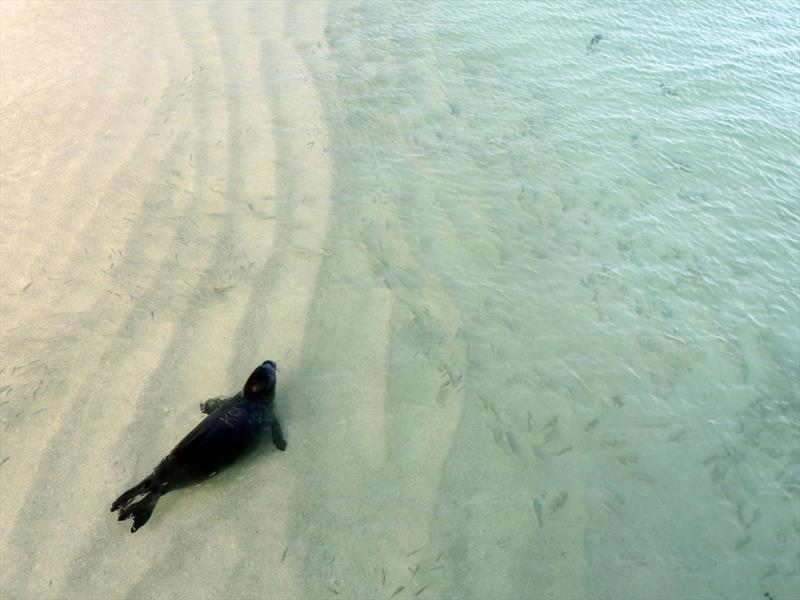
What's the latest on Hawaiian monk seals?
by NOAA Fisheries 16 Mar 2018 21:04 UTC

Hawaiian Monk Seal © NOAA Fisheries
Population update
NOAA Fisheries announces a status update on the Hawaiian monk seal population for 2017 with some positive signs for recovery as well as some persistent threats.
- The Hawaiian monk seal population remained stable in 2017, with close to 1,400 seals estimated across the species range.
- It was a good year for monk seal pups: 161 pups were counted in the Northwestern Hawaiian Islands and 34 in the main Hawaiian Islands (including everyone’s favorite famous pup, "Kaimana").
- The overall population trend is positive, showing a 2% annual growth rate since 2013 (when range-wide estimates were initiated).
- While recent population growth offers encouraging signs that strong conservation efforts can lead to progress, the monk seal population remains just over one-third of historic (1950s) levels. This highlights the importance of continued dedication to aid the recovery of this unique Hawaiian species.
Regional trends
Hawaiian monk seals are found only in Hawai‘i. Their population stretches across the archipelago from Hawai‘i Island, throughout Papahanaumokuakea Marine National Monument, to Kure Atoll. Population trends and threats differ from place to place across this large range.
- The recent positive trend in population numbers was largely due to years of improved juvenile survival in the Northwestern Hawaiian Islands, an important turn-around from previous patterns in this region.
- Populations in the main Hawaiian Islands appear to be leveling off after a period of expansion from the 1990s–early 2000s.
- While there have been no signs of ecological limitation in the main Hawaiian islands—pupping rates are still excellent for the species and animals appear in robust condition—several anthropogenic threats have the potential to limit recovery of monk seals in the main islands.
Threats
Threats in the Northwestern Hawaiian Islands include food limitation, shark predation (particularly at French Frigate Shoals), aggressive male seals, and entanglement in marine debris. The "big three" threats facing monk seals in the main Hawaiian Islands are toxoplasmosis, trauma, and interactions with shorecasting fishing gear and lay gill nets.
- Interactions with shorecasting gear pose a serious danger to seals, especially if the hooks are ingested. In 2017, 19 seals were observed hooked (two more with just fishing line). NOAA successfully removed seven of the hooks and cut three lines.
- Unattended nets are a grave threat to monk seals, if a seal becomes entangled in a net it could drown within minutes. In 2017, one seal was found dead in a lay gillnet and others were reported interacting with nets.
- Toxoplasmosis has emerged as a particularly harmful disease to Hawaiian monk seals. While disease may seem like a "natural" cause of mortality, toxoplasmosis is perpetuated by free-roaming cats, and thus linked to human alteration of the environment.
- Trauma continues to be a sad threat to monk seals. In 2017, two seals died due to trauma that appeared to be human-inflicted. NOAA investigates these cases and continues to work with communities to improve coexistence with Hawaii's marine animals.
Interventions
NOAA Fisheries makes great efforts to intervene and mitigate threats to monk seal survival.
- In 2017, NOAA was able to help 71 seals in the Northwestern Hawaiian Islands, thanks to the presence of staff in remote field camps.
- Interventions included disentangling trapped animals, moving pups from shark-prone beaches, rehabilitating malnourished juveniles, and more.
- The NOAA team intervened to help 22 seals in the main Hawaiian Islands, including de-hooking, translocating away from dangerous areas, and treating health issues.
- The NOAA monk seal team has been working hard to vaccinate monk seals against morbillivirus (a measles-like virus that can threaten marine mammals) and made major headway in 2017 by vaccinating nearly half of the population.
Community involvement
Heralded as "The Year of the Monk Seal," 2017 brought a surge of community involvement in monk seal stewardship that is encouraging to the species' conservation.
- Awareness of monk seals grew as the community watched young pup RJ58 ("Kaimana") grow up at Kaimana beach park. Community support for this seal pup was heartwarming, from news coverage to children's books and social media pages that kept the enthusiasm going.
- Local businesses stepped up for monk seal conservation, developing new monk seal-themed products and hosting special events.
- The number of volunteers helping to report seal sightings and monitor seals increased.
- Community groups also showed their support for monk seals in the past year—whether that support was producing a monk seal video, helping with beach clean-ups, or assisting citizen science efforts—it's encouraging to see Hawaiian monk seal conservation growing from the seeds of agency efforts to take root in the island community.